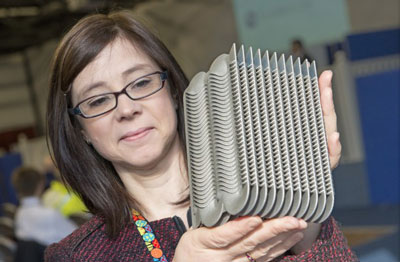| May 13, 2014 |
Using 3D printing to decommission nuclear power plants
|
|
(Nanowerk News) The company which runs Europe’s largest and most complex nuclear site is the first nuclear company in the world to experiment with innovative new uses for 3D scanning and printing.
|
|
Sellafield Ltd hopes to save the taxpayer hundreds of thousands of pounds by combining metal and plastic 3D scanning and printing to help them decommission some of the most potentially hazardous plants in the world.
|
|
Donna Connor, Head of Technical Capabilities at Sellafield Ltd, said: “Personally as a material scientist, 3D scanning and printing is the Holy Grail; the technology offers a huge amount of opportunity that we can exploit to continue the safe and accelerated clean up of Sellafield site.
|
 |
| Donna Connor, Head of Technical Capabilities at Sellafield Ltd getting to grips with a 3D metal printing
|
|
“The plants at Sellafield are unique and many of them have been used for far in-excess of their original design specification. Our Magnox Reprocessing plant, for example, was originally designed to work for 20 years and now, 50 years later, it is still recycling spent nuclear fuel from power stations around theUK.
|
|
“With these older plants lots of parts are one-off designs, which makes it both expensive and time consuming to replace parts. If something has to be custom manufactured it could mean a plant is closed down until a part is replaced, and even if we can avoid closing the plant temporarily, we know for certain that the part will be expensive. Using this technology can revolutionise the way we do things, saving time, and money for the taxpayer.
|
|
“Sellafield has always been a place where we’ve been first to do things. We were home to the world’s first nuclear power station in the 1950s, and continued to lead the way on nuclear energy for generations. It seems fitting that we should be the first nuclear company to be pioneering this new technology.”
|
|
Sellafield Ltd has already started using 3D scanning, and saved £25,000 by using 3D blue-LED scanning technology to design a new lid for a 40 tonne Solid Waste Export Flask, which is used to ship radioactive sludge across Sellafield site.
|
|
Now a conference has been held at the site, in Cumbria, to look at more ways in which they can utilize the newest 3D technology, metal printing, a process which fuses together very fine layers of metal powder with a focused laser beam to create parts and components in high performance metals.
|
|
Managing Director of Sellafield Ltd, Tony Price, said: “The nuclear pioneers of the 1940s and 1950s developed these plants at Sellafield, and were world leaders in their day. My team today has the chance to be the world leader once again, but this time in terms of decommissioning and waste storage.
|
|
|
|
“These emerging technologies are hugely exciting for the future legacy of our nation and the nuclear sector, and I’m proud to be able to say we were the first nuclear company to adopt them. It proves that Sellafield Ltd can stay at the forefront of the world’s nuclear industry.
|
|
“The technology has famously been used to build the titanium lattice frame for the Glasgow 2014 Commonwealth Games ‘Queen’s Baton’ and structural components for artificial satellites and Formula 1 cars.
|
|
“The quality of definition of these printers means that the products they produce are actually more accurate, stronger, and more reliable than parts made using traditional techniques. This is a really exciting development for us.”
|

